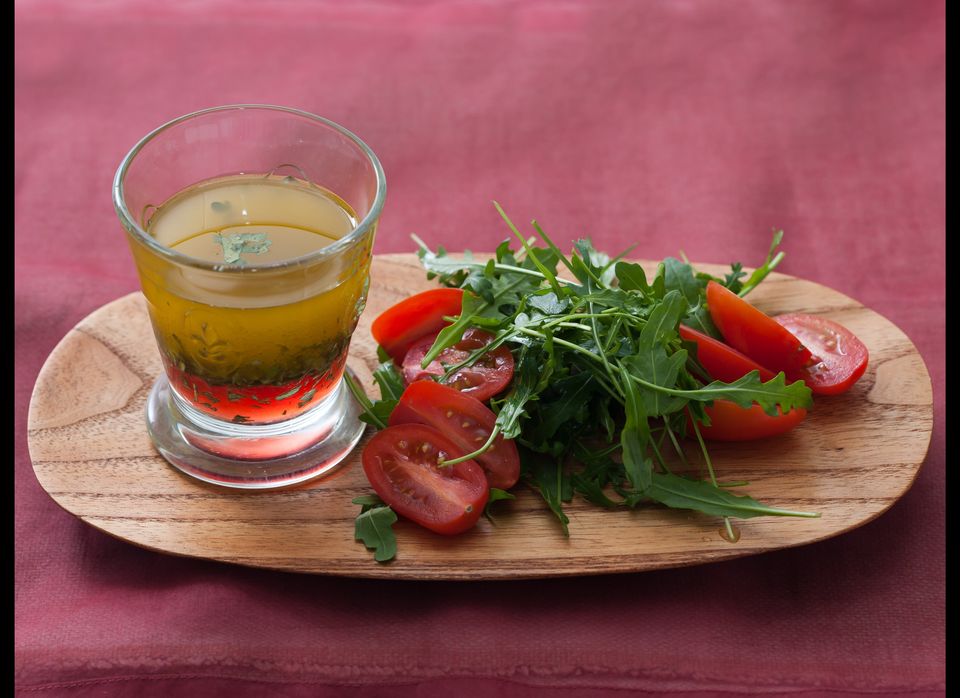
Cooking For Kitchenphobes is a series aimed to put "cooking haters" more at ease in the kitchen. We'll walk you through one basic recipe a week until you love cooking. Or else.
Quick, go to your refrigerator. Open the door. Take the bottled salad dressings out and throw them in the garbage. Take the garbage bag out into the street, and give it a few swift kicks. Now you're ready to make vinaigrette.
If you're thinking, "That's a bit drastic," you won't think so after we're done here. If you're thinking, "I don't like salad, I don't need to make vinaigrette," you're wrong. Vinaigrette isn't just salad dressing. It can be a dunking vessel for juicy roasted chicken, a mix-in for your rice or pasta, a marinade for your next steak, and the world's greatest accompaniment to roasted vegetables. And yes, it's also the most delicious blanket on the planet for salads.
Also, did we mention it's one of the easiest (and most rewarding) things to make? Enough talking, let's just make some. First, the simple rules of making a vinaigrette.
3 RULES FOR A CLASSIC VINAIGRETTE
1. There are four necessary ingredients: oil, vinegar (or lemon juice), salt and pepper. [Any neutral flavored oil will always work, such as olive, canola, corn, safflower or sunflower oil. And any kind of vinegar will work, as long as it's not too sour. Play around with different types until you find what you like.]
2. You can adjust amounts to suit your taste, but for starters, the oil-to-acid ratio of a classic vinaigrette should be approximately 3-to-1. [Acid = vinegar or lemon juice]
3. You can add more flavors. Try a little mustard, chopped herbs, garlic or shallots for some extra zing. We also love a touch of maple syrup or honey for sweetness.
HOW TO MAKE A CLASSIC VINAIGRETTE
1. Pour your vinegar (or lemon juice) into the bottom of a medium-sized mixing bowl. Add a pinch of salt, a pinch of pepper, and small amounts of other mix-ins [see #3 above] to the bowl. [Start small. You can always add more later.] Whisk it. Whisk it good.
2. Multiply the amount of vinegar you used by 3, and pour that amount of oil into a measuring cup. [For example: If you used 1/3 cup of vinegar, measure out 1 cup of oil.]
3. Get out a whisk.
4. Twist a kitchen towel into a long rope, and fashion the rope into a circle on your countertop. Nestle your mixing bowl inside the towel. [This will anchor the bowl as you're whisking, keeping it from walking across your counter. Seriously, this is a genius tip that you should tell your friends about.]
5. Very slowly, pour the oil into the vinegar in a slow, steady stream as you whisk with your other hand. Keep pouring and whisking until all the oil is in the bowl and you have a vinaigrette. [The goal here is to achieve emulsion, which is the marriage of oil and vinegar into a creamy consistency. There's no such thing as pouring too slowly or whisking too quickly here. If you pour too fast or whisk too slowly, the ingredients won't emulsify and your vinaigrette will separate.]
6. Taste it. If it's not right, adjust the missing ingredients, while whisking, until it tastes just right. Eat it, or refrigerate it.
How easy was that? Come back next week, when you'll learn to become an even more amazing cook. See you then!
Previously on Cooking For Kitchenphobes
Chicken Stock
Tomato Soup
